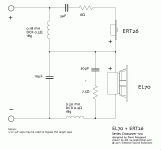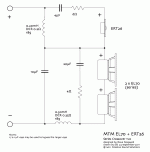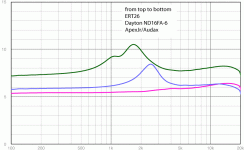Ah, I see what you're saying, and good point. I think the difference is, that top driver is inherently a .5 woofer because of it's location. It's off axis response at 90 degrees at 6khz will be dead. So the driver of concern in the xo is the forward facing driver.
Perhaps if Dave is reading this thread, as the designer, he could comment on how much treble that top driver is outputting.
Perhaps if Dave is reading this thread, as the designer, he could comment on how much treble that top driver is outputting.
Cogitech, I've got a pair of tweeters not in use right now (lets see if I can find them... Ah, here they are http://www.solen.ca/pdf/tangband/28847se.pdf ). I've measured them on a baffle and the spec sheet is actually pretty close. If you want, I see we're not too far from each other. I can ship them to you with a pair of .22mH inductors, some different caps. Check it out, see how it works for you. Send them back, or buy the parts off me for $20. I'm not using them. And I've received help here before.
Bob commissioned Dave Rosgard to do some XOs for the EL70, and has given me permission to post them. He will be working on gathering parts kits for these (and XIs for the CHBW+ERT70)
As per Robert's comment it will be noted that these are 2nd order. The MTM in particular is intriguing. The tweeter could likely be pod mounted on the top of Cogitech's Castles (the tweeter might need a little additional padding) or one could use the TM and just run the top EL70 FR (you'd need a secound amp or something 2 ohm capable.
I have the little Daytons, they are a nice form factor but not near the tweeter the ERT26
dave
As per Robert's comment it will be noted that these are 2nd order. The MTM in particular is intriguing. The tweeter could likely be pod mounted on the top of Cogitech's Castles (the tweeter might need a little additional padding) or one could use the TM and just run the top EL70 FR (you'd need a secound amp or something 2 ohm capable.
I have the little Daytons, they are a nice form factor but not near the tweeter the ERT26
dave
Attachments
... On top of that, there will be an impedance peak right at Fs that'll reduce the effectiveness of that cap, resulting in even less attenuation...
Given that it takes a smaller cap to XO a higher impedance driver wouldn't the opposite be the case? ie more attenuation.
dave
* a much higher first-order crossover (or as tuxedocivic says, just a cap but aim for a higher high pass)
This is where i would start, given the speakers that you are adding sparkle to:
Coupied from a post on another forum (that doesn't let me grab a URL for a specific post) hence the choice of example drivers
SteveTheShadow said:...a tweak to the Metronomes that has improved their performance....
You are pushing towards my approach to adding a superTweeter. I dispense with the L=Pad all together, instead using the attenuation of the 1st order XO to bring the tweeter in line with the FR. This only works with FR that hit at least 10k or so.
With am sT that is much more efficient than the FR you could be XOing VERy high (as an example T90 added to FE206eSR ends up being XOed with 0.33-0.47 uF.
C = 0.159 /(Rf) or f = 0.159/(8c)
If R = 8 then f ~ 0.02/C or nominal 42-64kHz XO point
So if we look at FF225wk FR
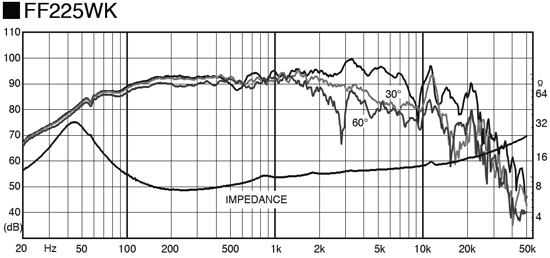
a good starting point is that we want to fill in above 10k -- we only need a starting point, since we will be fine tuning by ear.
Efficiency of FF225 is specced at 93 dB, FT17 at 98.5 or a 5.5 dB diff. Round up to 6 dB. So we want FT17 down 6 dB by 10k or a 20k estimated XO as a start point. With nominal 8 ohms this would be 1 uF. You can look at the actual impedance curve if you want. My measured one is limited by a 22k nyquist, here is the factory (which would indicate our 8 ohm approximation is pretty good):
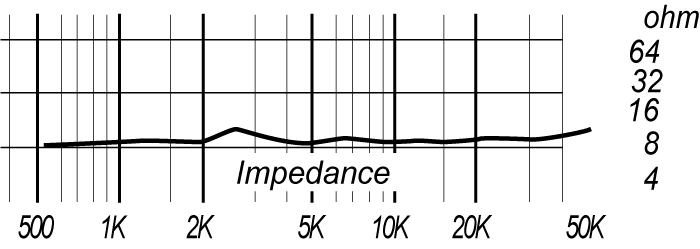
So you need a cap a step smaller than what you estimated, say 0.68, and a handful of 0.1 uF caps. Start with the "big" one, listen, add a 0.1 in parallel, listen, repeat until you are getting too much top, then back it off a step. Then go get a high quality cap of that value.
And an example of a pos-mounted tweeter:http://www.diyaudio.com/forums/full-range/192083-frugal-super-tweeter.html
An externally hosted image should be here but it was not working when we last tested it.
With the little Dayton it could be mounted naked on top with just a bit of bluetac. (see here)
dave
Given that it takes a smaller cap to XO a higher impedance driver wouldn't the opposite be the case? ie more attenuation.
dave
Think about what you just said and you'll see that I'm right. Higher impedance requires a more aggressive filter, so as impedance rises across Fs, the filter weakens and there will be a bump in the FR right there.
Yes you are right
But given the impedance rise of the ERT or the Dayton, likely not a lot of worry, and if the XO is up were it would be for just a cap XOed T you could get away with the ApexJr which has no issues with impedance rise, and is the price leader to boot.
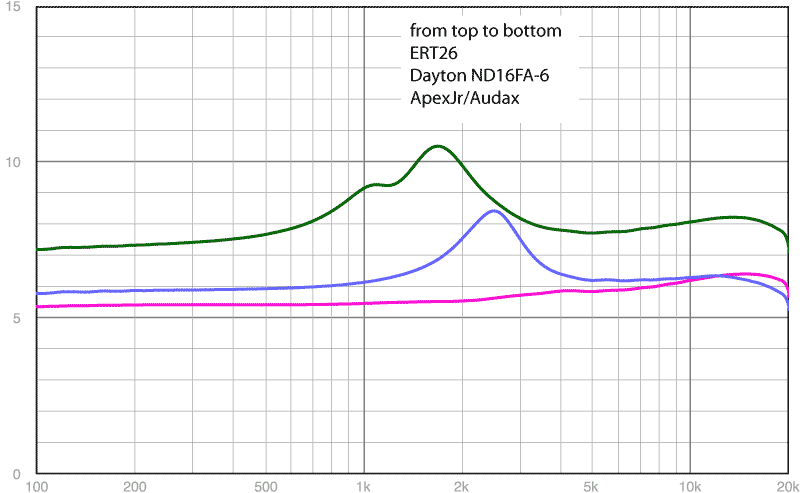
dave
But given the impedance rise of the ERT or the Dayton, likely not a lot of worry, and if the XO is up were it would be for just a cap XOed T you could get away with the ApexJr which has no issues with impedance rise, and is the price leader to boot.
dave
Attachments
Those are mild impedance plots, which is great. The problem is, Fs is going to be attenuated less than 9db no matter what the plot looks like, and that may sound like a door buzzer at even modest levels.
I think we're all agreeing to cross higher. With those schematics, now there's a lot less guessing 🙂
Is that apex a piezo? Or a ribbon? Price leader so likely not a ribbon 😉
I think we're all agreeing to cross higher. With those schematics, now there's a lot less guessing 🙂
Is that apex a piezo? Or a ribbon? Price leader so likely not a ribbon 😉
Last edited:
Is that apex a piezo? Or a ribbon? Price leader so likely not a ribbon 😉
An Audax dome, classes as 10mm, if one includes the surround they are about 20mm.
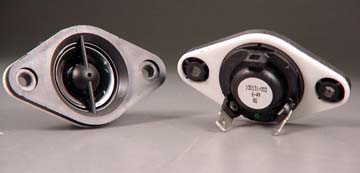
At a $1 apiece, post will cost more. I have about 15 pair here.
dave
The benefit of ferrofluid...
I have a number of broken ones... at some point i'm going to see if i can recover some of it.
dave
I have a number of broken ones... at some point i'm going to see if i can recover some of it.
dave
Cogitech, I've got a pair of tweeters not in use right now (lets see if I can find them... Ah, here they are http://www.solen.ca/pdf/tangband/28847se.pdf ). I've measured them on a baffle and the spec sheet is actually pretty close. If you want, I see we're not too far from each other. I can ship them to you with a pair of .22mH inductors, some different caps. Check it out, see how it works for you. Send them back, or buy the parts off me for $20. I'm not using them. And I've received help here before.
I've been too busy to visit the forum over the past few days, and just trying to catch up with all that has been discussed, but I wanted to take a quick second to thank you very much for this offer. Very generous of you! I will read the rest of the thread and check out the crossovers that Dave posted and once we get a bit of concencus on the "best" (I use the term loosely) approach , then I might just take you up on your offer.
Just some well intended notes:
- crossing over high leads to many lobes, sharply increasing with the distance between FR and tweeter. Top mounted (super)tweeters lead to freakish lobes.
- ferrofluid may seem like a good idea, but it isn't. You want to have an as high as possible Qms, and have as much of the control over the driver come from Qes. Ferrofluid acts as a brake and lowers Qms. High Qms means you will have to deal with an impedance peak, which is not difficult at all: LRC in series parallel to the driver.
In short, I would mount the tweeter as close as possible to the FR, and not cross over any higher than 3.5 kHz.
- crossing over high leads to many lobes, sharply increasing with the distance between FR and tweeter. Top mounted (super)tweeters lead to freakish lobes.
- ferrofluid may seem like a good idea, but it isn't. You want to have an as high as possible Qms, and have as much of the control over the driver come from Qes. Ferrofluid acts as a brake and lowers Qms. High Qms means you will have to deal with an impedance peak, which is not difficult at all: LRC in series parallel to the driver.
In short, I would mount the tweeter as close as possible to the FR, and not cross over any higher than 3.5 kHz.
In the microTowers of interest here, a top mounted tweeter is pretty much "as close as possible to the FR" as one can practically get. And an XO in the presence range is not a good idea (even if it is done alot -- avoiding such is one of the reason many like FRs)
Not always. Low Qms allows the use of a current amp. And the cure for high Qms (an LCR) may be worse than ferrofluid.
dave
You want to have an as high as possible Qms, and have as much of the control over the driver come from Qes. Ferrofluid acts as a brake and lowers Qms. High Qms means you will have to deal with an impedance peak, which is not difficult at all: LRC in series parallel to the driver.
Not always. Low Qms allows the use of a current amp. And the cure for high Qms (an LCR) may be worse than ferrofluid.
dave
I've been too busy to visit the forum over the past few days, and just trying to catch up with all that has been discussed, but I wanted to take a quick second to thank you very much for this offer. Very generous of you! I will read the rest of the thread and check out the crossovers that Dave posted and once we get a bit of concencus on the "best" (I use the term loosely) approach , then I might just take you up on your offer.
No problem. What goes around.
- Status
- Not open for further replies.
- Home
- Loudspeakers
- Full Range
- Would this work?
